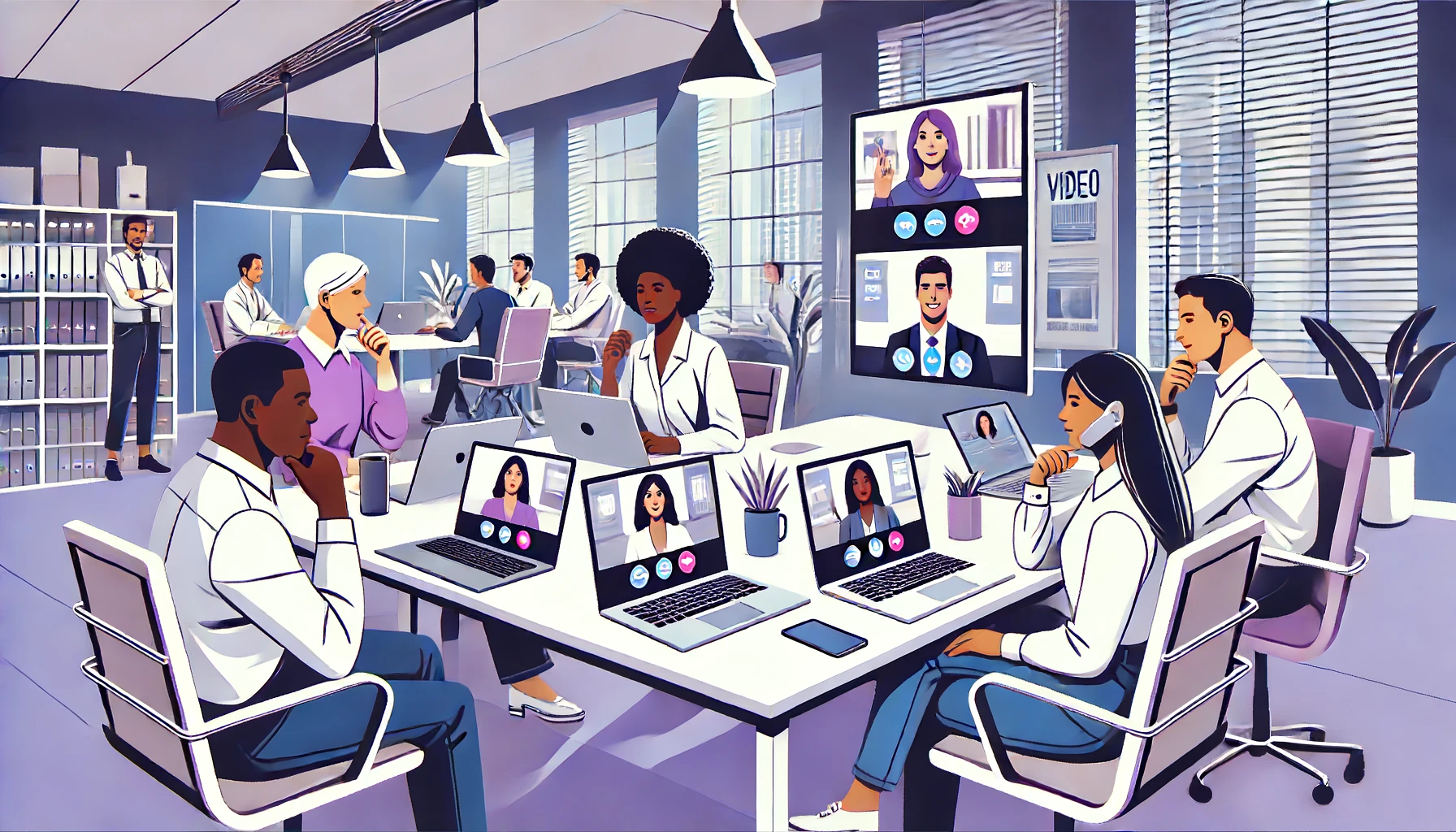9 Creative Employee Development Ideas for a Diverse Workforce


Turn your texts, PPTs, PDFs or URLs to video - in minutes.

With challenges like quiet quitting, coffee badging, and a highly competitive job market, attracting and retaining top talent has never been more crucial for professional organizations.
According to a late 2021 Gallup poll, 50% of workers would change jobs just to upgrade their skills, and 61% would stay at a company simply because it invests in their training and professional development. It's clear that quality skills and career development are what employees actually want.
However, successful retention doesn't just involve a bit of skills training. Employees of all levels expect innovative learning opportunities, or they'll jump ship to employers who offer them.
Creative development programs can help you meet these expectations while setting your organization apart. So, there's no need to stick with less productive, traditional employee training methods when you can make learning fun and impactful.
In this blog post, we present you with 9 creative employee development ideas and practical action steps to inspire and engage your mixed teams.
Why you need creative employee growth and development ideas
Change is the only constant in the (business) world, and 89% of L&D leaders are convinced that they must be proactive in building employees' skills to navigate the evolving future of work. Your organization is only as competitive as your employees. There's no doubt that professional development programs will benefit everyone.
Here's why L&D and HR professionals should go the extra mile to implement creative employee development ideas:
Millennials and Gen Zers have high expectations: These younger generations seek exciting workplaces with unique learning opportunities and are especially interested in leadership skills. Your creative development programs will align with these expectations, helping you to attract and retain employees from these generations.
Creative L&D gives competitive advantages in recruitment: Once you prioritize creative employee development ideas, you'll gain the reputation of a forward-thinking, employee-centric company. Thus, you'll attract top talent and be more competitive.
Increased participation means better learning outcomes: Employees are more likely to participate actively when training is fun and engaging. Whether it's technical or soft skills training, they'll take ownership of their learning and remember more of it.
Creative training encourages out-of-the-box thinking: Unique career development programs spark creative thinking and problem-solving. This leads to new ideas and solutions and helps build a culture that values and promotes innovation. Research shows that innovative firms have higher profits and added value.
Idea 1: Turn your employees into video creators
Two major things happen when you let employees share their knowledge with colleagues: 1) You make the most of internal expertise, and 2) You create highly relevant and customized training content. What's more, if you choose an AI video maker to ease their job, you'll help them gain new content creation skills and encourage a culture of continuous learning and innovation.
To achieve this, you must first select:
- Employees with subject matter expertise and interest in video creation.
- An AI video tool such as Synthesia, Loom, or Camtasia.
Give your experts a beginner's guide to AI video creation and ask them to experiment with your chosen tool. This process alone will significantly enhance their professional development and foster a culture of continuous learning and innovation.
Next, set objectives for content creation — these could include upskilling interns, developing product tours, creating more standardized materials for support agents, etc.
Here's an example of a video that your employees could easily put together with an AI text-to-video tool:
As they start creating videos for their colleagues, you can publish them on an internal platform for easy access.
Why video creation fosters employee growth:
- Empowers employees to share knowledge.
- Promotes a collaborative learning environment.
- Increases engagement through creative involvement.
Idea 2: Use interactivity and gamification to make learning more exciting
Gamified learning done right feels like play and enhances retention through interactive elements and rewards. It also increases engagement and motivation, making training sessions more effective and enjoyable — that's why 95% of employees actively seek work experiences that include gamification.
Quizzes are particularly enjoyable, and you could help your employees learn with interactive training that includes instant-feedback quizzes, like a safety quiz, a customer support quiz, or even this interactive customer service training about gaining control of a situation:
All these examples were made in Articulate 360, an authoring tool that lets you upload any video you create and add interactive elements to it. Other platforms where you can add gamification elements to your videos are Kahoot! and EdApp.
Interactivity and gamification are excellent development ideas that:
- Make professional development fun and engaging.
- Encourage active participation in development opportunities.
- Provide immediate feedback and a rewards program.
Idea 3: Try role reversal shadowing
Shadowing is as close as a learner can get to an expert and soak up their knowledge during a practical, real-life demonstration. Role reversal shadowing, however, brings an interesting twist to a mentoring program. It promotes empathy and understanding between different levels of employees and provides fresh perspectives on job roles and processes.
To give your mentorship program this transformative twist, pair junior and senior employees for a shadowing day. This experience promotes empathy and understanding and prepares junior employees for leadership roles or other career paths by exposing them to senior-level responsibilities. Have the junior employee shadow the senior in the morning and reverse roles in the afternoon. Ideally, each day, they should conclude with a creative solution-oriented session.
Slack is a great tool for communication and exchanging information or feedback if the two of them can't really spend the entire day together. Alternatively, you can experiment with Zoom if you need to implement virtual shadowing, like when employees hop on calls with customers, and their shadows must also attend.
How role reversal shadowing benefits your employees:
- Enhances mutual understanding and talent development.
- Promotes knowledge sharing and leadership skills.
- Identifies process improvements from diverse viewpoints.
Idea 4: Organize "lunch, learn & craft" sessions
Although arts and crafts are social activities that don't directly improve work-related skills, they can still make excellent staff development ideas. After all, they're a great team-building activity that boosts employee morale and creativity and reduces stress. Team members can bond over shared activities like painting, jewelry making, calligraphy, pottery, knitting, etc., and improve their focus and patience while building confidence.
The employee development plan is pretty straightforward here. Schedule monthly workshops on various crafts, invite local artists or experts to lead the sessions, and provide materials and a relaxed space for the activity. Always encourage every team member to share their creations and experiences so these sessions become a valuable part of your company culture.
Why craft sessions are exciting employee development ideas:
- Enhance out-of-the-box thinking.
- Reduce stress and improve focus.
- Encourage team building and communication.
Idea 5: Develop mobile-friendly microlearning modules
Microlearning modules provide bite-sized, easily digestible content that employees can access anytime, anywhere. This approach fits into busy schedules and enhances retention. The cognitive load is significantly smaller than with heavy training and employees are more likely to go through and remember these nuggets of information.
Look into software like EdApp, TalentCards, or GoConqr, to get a feel for what kind of microlearning training you can create. Then, identify key topics you'd like to approach and start creating concise, focused content optimized for mobile use.
Here's a super quick tutorial on how to create microlearning videos with Synthesia for your employee development program.
Reasons to use microlearning for creative employee development:
- Fits into busy schedules.
- Increases retention with concise content.
- Provides flexible, on-the-go learning for professional growth.
Idea 6: Teach burnout management through interactive workshops
Taking good care of your employees has never been more important than in today's increasingly competitive marketplace. Work can often take a toll on your employees' mental health. Teaching burnout prevention strategies for specific work environments and stress management techniques (like deep breathing, progressive muscle relaxation, or time management skills) will make it easier for your employees to cope.
If you want to have a healthier, more productive workforce, you can't just preach burnout management. You've got to make it practical. Interactive workshops are a great way to equip employees with hands-on techniques that promote their well-being and increase productivity.
Schedule regular workshops focusing on stress management techniques and use interactive methods such as role-playing and group discussions. Provide resources for ongoing support and encourage employees to experiment with Headspace or other apps for guided meditations. Always follow up with individual check-ins.
How burnout management workshops favor staff development:
- Provide practical, applicable skills.
- Encourage open discussion about mental health.
- Support long-term employee well-being.
Idea 7: Improve problem-solving skills with role-playing scenarios
Artificial intelligence can be of great use for generating dialogues around specific work-related problems. AI-powered role-playing scenarios offer realistic, dynamic training that helps employees enhance their problem-solving skills and prepares them for actual workplace challenges in a safe environment.
You can generate such scenarios using an AI tool like IBM Watson, Rehearsal Video Role-Play, or Synthesia, and organize regular role-playing sessions. To reinforce learning and improve, debrief your team members, discuss the lessons learned, and collect their feedback on the experience.
Here's a template from Synthesia that you can duplicate and customize to create countless video role-playing scenarios:
Why use this creative employee development idea:
- Provides realistic practice in a safe environment.
- Enhances critical thinking.
- Favors leadership development.
Idea 8: Design job rotation cycles every 6 months
Job rotation exposes employees to different roles, improving specific skills and understanding of the organization. This increases flexibility, reduces monotony, and makes them more agile. The key, however, is to let them experiment with different roles without disrupting the workflow.
Make sure you include a mix of roles within different departments for exposure to a wide range of skills and functions. And offer specific employee training sessions at the beginning of each rotation to equip employees with the skills and knowledge for their new roles. But don't forget about performance reviews at the end of the cycle either.
Use Trello to create a rotation schedule and define objectives for each cycle and BambooHR to track rotations and conduct evaluations at the end of each rotation cycle.
Job rotation encourages employees to step outside their comfort zone and:
- Broadens skill sets and perspectives.
- Increases employee engagement and satisfaction.
- Enhances organizational agility.
Idea 9: Create a video database for just-in-time online employee development
A video database allows employees to access training materials on demand, promoting self-paced learning. This resource can be continually updated to reflect current best practices and must be promoted so employees don't forget about the resources you've made available for them.
To develop a video library, first, identify the key training topics and create corresponding videos using your favorite video maker. You can rely on Notion to organize your database and Vimeo to host the videos. Then, organize your content into a searchable database and pick a champion to promote it.
Benefits of creating a video database for employee growth:
- Provides on-demand learning opportunities for professional growth.
- Supports diverse learning styles and promotes various specific skills.
- Ensures up-to-date training resources.
Discover the power of AI videos for creative employee development
Videos can be used for anything from exciting training sessions to out-of-the-box internal communications. Until recently, the major drawback was that creating them required special skills, equipment, and a generous budget. But thanks to generative AI, that's no longer the case.
Software like Synthesia can turn your text-based employee development ideas into videos in minutes. These videos showcase diverse AI avatars that speak almost any language, model dialogues, express emotions, and teach anything from soft to hard skills.
Find out here how you can create training videos in 120+ languages. You'll hook your employees with resources and professional development activities that make them feel valued and supported.
About the author
Learning Strategist & Speaker
Elly Henriksen
Elly Henriksen is a accomplished instructional designer exploring the impact of AI-generated content on learning design.











